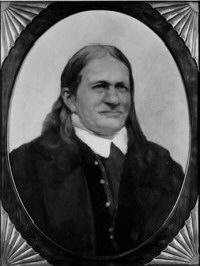Friedlieb Ferdinand Runge
You can help expand this article with text translated from the corresponding article in German. (February 2019) Click [show] for important translation instructions.
|
Friedlieb Ferdinand Runge | |
|---|---|
 | |
| Born | 8 February 1794 |
| Died | 25 March 1867 (aged 73) |
| Nationality | German |
| Alma mater | University of Jena, University of Berlin |
| Scientific career | |
| Institutions | University of Berlin, University of Breslau |
| Doctoral advisor | Johann Wolfgang Döbereiner |
Friedlieb (or Friedlob, occasionally misnamed as Friedrich) Ferdinand Runge (8 February 1794 – 25 March 1867) was a German analytical chemist. Runge identified the mydriatic (pupil dilating) effects of belladonna (deadly nightshade) extract, identified caffeine, and discovered the first coal tar dye (aniline blue).
Early life
Friedlieb Ferdinand Runge was born near Hamburg on 8 February 1794. From a young age, Runge conducted chemical experiments, serendipitously identifying the mydriatic (pupil dilating) effects of belladonna (deadly nightshade) extract.
Career
In 1819 he demonstrated his finding to Goethe, who encouraged him to analyse coffee.[1] A few months later, Runge identified caffeine.[2]
Runge studied chemistry in Jena and Berlin, where he obtained his doctorate. After touring Europe for three years, he taught chemistry at the University of Breslau until 1831. From then until 1852 he worked for a chemical company, but was dismissed by a resentful manager and died fifteen years later in poverty, in Oranienburg.
Discoveries
His chemical work included purine chemistry, the identification of caffeine, the discovery of the first coal tar dye (aniline blue),[3] coal tar products (and a large number of substances that derive from coal tar), paper chromatography,[4] pyrrole, chinoline, phenol, thymol and atropine.
He was the first to notice in 1855 the phenomenon of "Liesegang rings". He observed them in the course of experiments on the precipitation of reagents in blotting paper.[5][6]
Gallery of images
-
Commemorative plaque in Oranienburg. It reads: Historical site of the Oranienburg chemical product factory, whose technical director from 1832–1852 was Prof. Dr. Friedlieb Ferdinand Runge, discoverer of coal tar dyes.
-
Grave in Oranienburg
-
Memorial in Oranienburg
References
- ^ In 1819, Runge was invited to show Goethe how belladonna caused dilation of the pupil, which Runge did, using a cat as an experimental subject. Goethe was so impressed with the demonstration that: "Nachdem Goethe mir seine größte Zufriedenheit sowol über die Erzählung des durch scheinbaren schwarzen Staar Geretteten, wie auch über das andere ausgesprochen, übergab er mir noch eine Schachtel mit Kaffeebohnen, die ein Grieche ihm als etwas Vorzügliches gesandt. "Auch diese können sie zu Ihren Untersuchungen brauchen," sagte Goethe. Er hatte recht; denn bald darauf entdeckte ich darin das, wegen seines großen Stickstoffgehaltes so berühmt gewordene Coffein." (After Goethe had expressed to me his greatest satisfaction regarding the account of the man [whom I'd] rescued [from serving in Napoleon's army] by apparent "black star" [i.e., amaurosis, blindness] as well as the other, he handed me a carton of coffee beans, which a Greek had sent him as a delicacy. "You can also use these in your investigations," said Goethe. He was right; for soon thereafter I discovered therein caffeine, which became so famous on account of its high nitrogen content.)
This account appeared in Runge's book Hauswirtschaftlichen Briefen (Domestic Letters [i.e., personal correspondence]) of 1866. It was reprinted in: Johann Wolfgang von Goethe with F.W. von Biedermann, ed., Goethes Gespräche, vol. 10: Nachträge, 1755–1832 (Leipzig, (Germany): F.W. v. Biedermann, 1896), pages 89–96; see especially page 95. - ^ Runge, Friedlieb Ferdinand (1820). Neueste phytochemische Entdeckungen zur Begründung einer wissenschaftlichen Phytochemie [Latest phytochemical discoveries for the founding of a scientific phytochemistry]. Berlin: G. Reimer. pp. 144–159.
- ^ Runge called aniline blue "Kyanol" (blue-oil). See:
- F. F. Runge (1834) "Ueber einige Produkte der Steinkohlendestillation" (On some products of coal distillation), Annalen der Physik und Chemie, 31 : 65–78.
- F. F. Runge (1834) "Ueber einige Produkte der Steinkohlendestillation," Annalen der Physik und Chemie, 31 : 308–328.
- F. F. Runge (1834) "Ueber einige Producte der Steinkohlen-destillation," Annalen der Physik und Chemie, 31 : 513–524.
- ^ Runge placed drops of reactant solutions on blotting paper and then added a drop of a second reactant solution on top of the first drop. The solutions would react as they spread through the blotting paper, often producing colored patterns. His results were published in two books:
- F. F. Runge, Farbenchemie. Musterbilder für Freunde des Schönen und zum Gebrauch für Zeichner, Maler, Verzierer und Zeugdrucker, dargestellt durch chemische Wechselwirkung [Color chemistry. Sample images for friends of beauty and for use by sketchers, painters, decorators, and printers, prepared by chemical interaction] (Berlin, (Germany): (Self-published), 1850).
- F. F. Runge, Der Bildungstrieb der Stoffe, veranschaulicht in selbstständig gewachsenen Bilder [The formative tendency of substances illustrated by autonomously developed images] (Oranienburg, (Germany): (Self-published), 1855).
- ^ Henisch, Heinz K. (1988). Crystals in Gels and Liesegang Rings. Cambridge University Press. p. 2. Retrieved 31 May 2015.
- ^ Friedlieb Ferdinand, Runge (1855). Der Bildungstrieb der Stoffe : veranschaulicht in selbstständig gewachsenen Bildern (Fortsetzung der Musterbilder). Oranienburg : Selvstverlag : Zu haben in Mittler's Sortiments-Buchhandlung, in Berlin, Stechbahn No. 3. Retrieved 31 May 2015.
Sources
- Weinberg BA, Bealer BK. The world of caffeine. New York & London: Routledge, 2001. ISBN 0-415-92722-6.
- G. Kränzlein (1935). "Zum 100 jährigen Gedächtnis der Arbeiten von F. F. Runge". Angewandte Chemie. 48 (1): 1–3. doi:10.1002/ange.19350480103.
- H. H. Bussemas, G. Harsch and L. S. Ettre (1994). "Friedlieb Ferdinand Runge (1794–1867): "Self-grown pictures" as precursors of paper chromatography". Chromatographia. 38 (3–4): 243–254. doi:10.1007/BF02290345.
Further reading
- Anft, Berthold, with R. E. Oesper, trans. (1955) "Friedlieb Ferdinand Runge: A forgotten chemist of the nineteenth century," Journal of Chemical Education, 32 : 566–574.
- Anft, Bertold, Friedlieb Ferdinand Runge: sein Leben und sein Werk [Friedlieb Ferdinand Runge: his life and his work] (Berlin, Germany: Dr. Emil Ebering, 1937).



